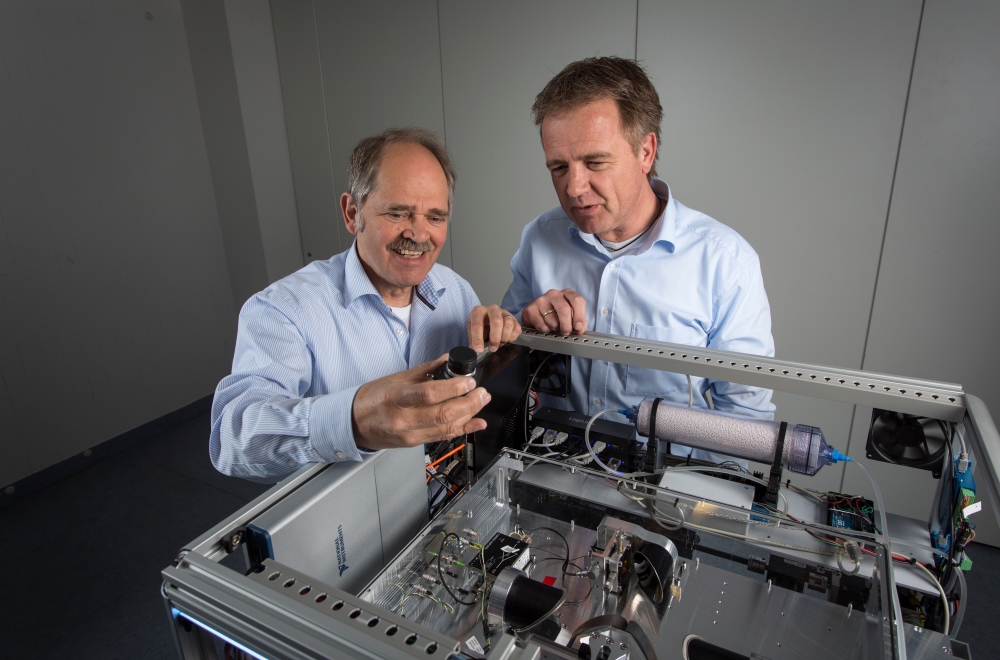Fraunhofer IPM and Hübner win Joseph von Fraunhofer prize 2014
Prof. Dr. René Beigang from Fraunhofer IPM and Dipl.-Ing. Thorsten Sprenger, Head of Public Security and Photonics at Hübner GmbH & Co.KG in Kassel, win one of this years’ Fraunhofer prizes. They were awarded for the development of the mail scanner »T-COGNITION«. Their system is capable of detecting and identifying the hidden content of suspicious packages or envelopes without having to open them. This is possible by using terahertz waves.

Is it a harmless parcel or a bomb? For mailrooms of large companies, government agencies, prisons or embassies this question rises day by day. »T-COGNITION«, developed by Professor Dr. René Beigang in collaboration with Dipl.-Ing. Thorsten Sprenger and their teams now offers a reliable security-check for suspicious packages without having to open them.
Handling is easy: Suspicious envelopes and packages are fed into the scanner on a retractable tray. They are then exposed to terahertz waves which are absorbed at different frequencies within the spectral range depending on the substance they travel through (characteristic absorption properties). Detectors record the transmitted wavelengths. »Within a few seconds, T-COGNITION produces a spectroscopic fingerprint that allows the detected hazardous material to be compared with database samples and definitively identified«, says Thorsten Sprenger. The system triggers an alarm if the consignment contains explosives or illicit drugs.
The system is capable of examining the content of postal items up to C4 format with a thickness of up to two centimeters. Sprenger says: »It is the ideal mailroom solution for prisons, customs offices, government agencies, company headquarters, and embassies or consulates, because it helps to improve security and protect human lives.«
Terahertz – Technology with tremendous potential
Professor René Beigang explains: »The terahertz range lies midway between microwave and infrared in the electromagnetic spectrum, and thus combines the advantages of both.« Like microwaves, these low-energy frequencies can easily penetrate paper, wood, lightweight fabrics, plastics, and ceramics. Moreover, terahertz waves generate characteristic spectra depending on the type of material they travel through, which can be analyzed quickly using intelligent software. A further significant advantage is that terahertz waves are non-ionizing and therefore safe to use in an unprotected environment, unlike X-rays. This makes the technology an interesting option for use in mail scanners.
Terahertz technology is still in its infancy, and until now it has found relatively few applications. The department of Material Characterization and Testing at the University of Kaiserslautern, sponsored jointly by Fraunhofer IPM and the Land of Rheinland-Pfalz, hopes to change this situation.
»Our goal is to scale up terahertz technology and extend its range of use to include security applications«, says Beigang. The engineers at Hübner were among the first to recognize the potential of the Fraunhofer researchers’ work. The company’s traditional line of business is manufacturing key components for the transportation industry (e.g. rail vehicles, buses, airport technology, automotive). A new division for public security was added in 2006, when the company first started to look for cooperation partners. The mail scanner project was launched four years later, based on previous joint development projects. In the meantime, the company has brought its »T-COGNITION« solution onto the market.
»T-COGNITION« recently received the PrismAward, the equivalent of an Oscar in the photonics world, at the Photonics West 2014 international congress in San Francisco.
Background: Joseph von Fraunhofer prize – research for practical applications
This prize has been awarded by the Fraunhofer-Gesellschaft every year since 1978, in recognition of outstanding scientific work by members of its staff leading to the solution of application-oriented problems. To date, more than 200 researchers have received this honor.
- Video Mail Scanner (fraunhofer.de)
- Terahertz mail scanner